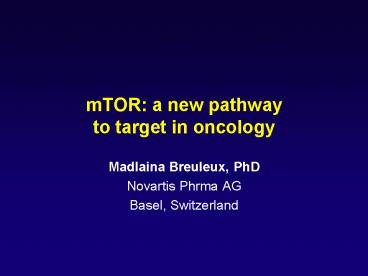mTOR: a new pathway to target in oncology
1 / 19
Title:
mTOR: a new pathway to target in oncology
Description:
... Broad in vivo antitumor activity mTOR inhibition decreases angiogenesis Evidence of antiangiogenic activity Tumor xenograft bearing mice: single 5 mg/kg ... –
Number of Views:155
Avg rating:3.0/5.0
Title: mTOR: a new pathway to target in oncology
1
mTOR a new pathwayto target in oncology
- Madlaina Breuleux, PhD
- Novartis Phrma AG
- Basel, Switzerland
2
The mTOR pathway and cancer
mTOR (mammalian Target Of Rapamycin)
- A high molecular weight serine-threonine kinase
- Senses and responds to cellular nutrient and
energy levels - Influences protein translation regulating G1
progression, S-phase entry, and ultimately cell
growth and proliferation - Functions downstream of the PI3 kinase / AKT
pathway, which is often deregulated in human
cancer - mTOR pathway deregulation causes loss of growth
control in cancer
3
mTOR A central controller of tumor cell growth
4
mTOR A controller of angiogenic processes
5
RAD001 (Everolimus) An oral mTOR pathway
inhibitor
- Broad antiproliferative and antitumor properties
- Inhibits the mTOR pathway
- Sensor of physiological signals
- Downstream of PI3K / AKT pathway
- RAD001 activity associated with overactivation of
the PTEN / PI3K / AKT pathway
- Inhibits tumor cell growth
- Delays G1/S phase progression
- Sensitises tumor cells to targeted and
chemotherapeutic agents
- Anti-angiogenic properties
- Direct and indirect activity
- Phase IB/II clinical trials in oncology
Model of RAD001 binding to intracellular receptor
(FKBP-12) to form complex inhibiting mTOR pathway
6
p-AKT levels correlate with RAD001 sensitivity
7
RAD001 Broad in vivo antitumor activity
8
mTOR inhibition decreases angiogenesis
- mTOR regulates HIF-1a and HIF-2a expression
(transcription factors mediating hypoxia-induced
gene expression) - HIF-1a/2a are normally degraded by VHL protein
- HIF-1 and HIF-2 condition the tumor to adapt to
growth under hypoxic conditions and promote
angiogenesis and metastasis
HIF hypoxia-inducible factor VHL von
Hippel-Lindau protein.
9
Evidence of antiangiogenic activity
- Tumor xenograftbearing mice single 5 mg/kg oral
dose - RAD001 plasma levels never exceed the in vitro
IC50 for HCT116 (colon) or KB-31 (epidermoid)
tumor cells - However, both HCT116 and KB-31 xenografts are
sensitive to RAD001 in vivo at this dose - RAD001 levels exceed the in vitro IC50 for VEGF-
or FGF-stimulated human umbilical vein
endothelial cultures (HUVECs) - RAD001 inhibits tumor cell VEGF production in
vitro and decreases tumor and plasma VEGF levels
in animal models - RAD001 selectively inhibits VEGF-dependent
angiogenic response in vivo, and reduces
microvessel density in tumors derived from
sensitive or resistant cell lines - These data suggest an antiangiogenic effect
against tumors
10
RAD001 reduces microvessel density (B16/BL6)
Vehicle Controls
RAD001
Significant reduction in microvessel density
following RAD001 treatment in primary tumor and
cranial lymphnode metastases (shown)
11
RAD001 Combination potential
Although RAD001 has antiproliferative activity as
a monotherapy, its potential may be better
realized in combination with other therapeutic
agents
- Chemotherapeutics
- DNA-damaging agents (i.e. cisplatin,
temozolomide) - Topoisomerase inhibitors (i.e. doxorubicin)
- MT active agents (i.e. Taxol)
- Targeted therapeutics
- ErbB inhibitors (i.e. AEE788 trastuzumab)
- Estrogen antagonists - aromatase inhibitors (i.e.
letrozole) - BCR-ABL, Kit inhibitors (i.e. imatinib)
- VEGFR inhibitors (i.e. PTK787)
- IGF-1R inhibitors (i.e. AEW541)
- Radiotherapy
12
Combinations with cisplatin(in RAD001-sensitive
H596 NSCLC xenografts)
Tumor Volumes
Body Weights
Combinations of RAD001 and low-dose cisplatin
elicit a more potent antitumor effect than either
agent alone (also in model derived from resistant
line)
P lt 0.05 versus controls by the Dunnett test.
13
Cisplatin combinations Potentiate cell
death(A549 cells cell death with sub-optimal
cisplatin concentrations)
Significant fold induction with P lt 0.05,
t-tests two-way ANOVA indicates
highlysignificant interaction between RAD001 and
cisplatin P lt 0.001.
14
Cell death is dependent on p53 status
Significant fold induction with P lt 0.05,
t-tests.
15
The p53/p21 response
- DNA damage (i.e cisplatin treatment) activates
p53. - In the presence of extensive DNA damage, p53
initiates a cell death program. - In the presence of sub-optimal DNA damage, p53
induces p21 expression, a cell cycle inhibitor,
allows DNA repair (and cell survival). - RAD001 inhibits p21 expression forcing tumor cell
death even at suboptimal cisplatin concentrations
(non-lethal DNA damage)
Beuvink et al. Cell. 2005120747-759.
16
Rationale for combination with letrozole
- Akt activation predicts a worse outcome for
breast cancer patients treated with endocrine
therapy. - Activated Akt mediates resistance to antiestrogen
therapy (related to HER2 overexpression). - mTOR inhibition restores responses to tamoxifen
in breast cancer models with high levels of Akt
activity. - Synergistic in vitro and in vivo effects have
been seen with combined antiestrogen therapy and
mTOR inhibition.
17
Inhibition of estrogen-induced proliferation(arom
atase-expressing MCF7 cells)
Highly significant interactions (??? p lt 0.001
two-way ANOVA) Synergistic effects (isobologram
analysis) Also in aromatase-expressing T47D cells
18
Potential RADIANT Trials
TUNEL
YOPRO
Decreased cell viability as compared to single
agents (YOPRO ?? p lt 0.01 two-way
ANOVA). Defined as apoptosis (TUNEL ? p lt 0.05
Friedman Test). Also in aromatase-expressing T47D
cells
19
Summary
- mTOR acts as a central regulator of tumor cell
growth and survival, and activation of the
PI3K/AKT pathway may predict tumor response to
mTOR inhibition. - RAD001 exhibits a broad antitumor activity, and
inhibits elements of the angiogenic process. - Combination therapy targeting mTOR and other
targets/processes deregulated in human cancer may
provide enhanced anticancer activity.
Targeting deregulated pathways has been a
successful clinical strategy in cancer.































